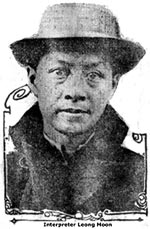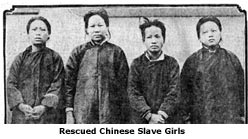




In 1912 Leong Moon, interpreter on the Japanese liner Nippon Maru, and four Chinese girls, captured by immigration. Based on testimonies from the Chinese girls Federal investigators concluded the possibility that they stumbled upon a smuggling ring with the cargo of Chinese woman and coolies, promising them rich husbands and an easier life. The Chinese girls, disguised as men once ashore, and were caught after a failed attempt to bribe a customs guard. The girls reported that they were drugged in Hong Kong and lured aboard the ship. Isolated in a coal bunker compartment and during the ocean trip occasionally small portions of rice were lowered to them like they were caged animals.
This particular incident was incredibly detrimental to Chinatown society during the time. Not only did Leong Moons break several immigration laws, he was an American born Chinese. The treatment of the women in this smuggling ring commented on cultural values of Chinese Americans as well as the value of their women. Outside of this specific incident the Chinese Slave girls or “Celestial Slaves” took back breaking jobs to make ends meet such as that of field hands on vineyards and orchards, those who were fortunate found occupations as nannies and house servants. Since Chinese people weren’t allowed to own land Chinese women would commonly have miniature farms in their living quarters such as chicken coops in backyards bean sprouts growing in bathtubs. This standard of living as well as the occupation of these women reinforced the idea of the stereotypical coolie and pollutants of the yellow peril archetype. Films like Walk Like a Dragon (1960) featured this type of slave girl with a White male hero protagonist trying to save them from their cultural prisons. The main character Linc Bartlett falls in love with a nineteen year old Kim Sung who is being sold at a slave market, in the end of the film she if forced to choose between the American Linc of the traditionalist Cheng. She ends up with Cheng only under the circumstance that he finally adopted American values towards women. The idea of the Chinese slave girl would create a legacy of Orientalist and servile representation of women in Hollywood media. Films like The World of Suzie Wong and plays like Madame Butterfly where prostitutes and women of servile situations would fall victim to either American rejection or Asian cultural barriers.
http://www.nwhm.org/chinese/27.html
http://www.californiahistoricalsociety.org/collections/photo_collection/genthe/FN-02333-GentheCT-044.jpg
http://www.tcmuk.tv/movie_database_results.php?action=title&id=94995
http://www.sfmuseum.org/hist10/chingirls.html
http://katmeyer.serverpro2.com/_Lords_Early_Career/walk_like_a_dragon_2.jpg
Ty Tran Nguyen
No comments:
Post a Comment